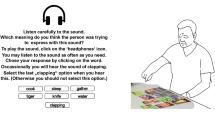Abstract
Ninety-two Hebrew-speaking subjects judged the magnitude, brightness, and hardness symbolism of orthographic characters designating five vowel phonemes in Hindi and in Japanese. For both languages and all three symbolic dimensions, the figural symbolism of the orthographic characters was found to replicate very closely the sound symbolism of their phonemic referents. The ranking of the five vowel characters in order of increasing magnitude and decreasing brightness and hardness was as follows:i, e, a, u, o. The results were interpreted to suggest that sound patterns and visual patterns tend to carry cross-culturally consistent connotations, and that the symbolic implications of sounds have been embodied in the pattern of orthographic characters in natural languages.
Similar content being viewed by others
References
Bentley, M., and Varon, E. J. (1933). An accessory study of phonetic-symbolism.Am. J. Psychol. 45: 76–86.
Birch, D., and Erickson, M. (1958). Phonetic-symbolism with respect to three dimensions of the semantic-differential.J. Gen. Psychol. 58: 291–297.
Brown, R. (1958).Words and Things, Free Press, New York.
Cassirer, E. (1953).The Philosophy of Symbolic Forms, Yale University Press, New Haven.
Coombs, C. H. (1964).A Theory of Data, Wiley, New York.
Davis, R. (1961). The fitness of names to drawings: A cross-cultural study in Tanganyika.Brit. J. Psychol. 52: 259–268.
Diringer, D. (1968).The Alphabet: A Key to the History of Mankind, Hutchinson, London.
Fox, C. W. (1935). An experimental study of naming.Am. J. Psychol. 47: 545–579.
Guilford, J. P. (1954).Psychometric Methods, McGraw-Hill, New York.
Holland, M. K., and Wertheimer, M. (1964). Some physiogonomic aspects of naming, or, Maluma and Takete revisited.Percept. Mot. Skills 19: 111–117.
Irwin, J. W., and Newland, E. (1940). A genetic study of the naming of visual figures.J. Psychol. 9: 3–16.
Johnson, R. C. (1967). Magnitude symbolism of English words.J. Verb. Learn. Verb. Behav. 6: 508–511.
Karwosky, T. F., and Odbert, H. S. (1938). Color-music.Psychol. Monogr. 50: 1–60.
Karwosky, T. F., Odbert, H. S., and Osgood, C. E. (1942). Studies in synaesthetic thinking. II. The role of forms in visual responses to music.J. Gen. Psychol. 26: 199–122.
Khan, S. (1944).The Jadid Hindustani Teacher: Hindustani by a New Method, Qamar Bros., Simala.
Kohler, W. (1947).Gestalt Psychology, Liveright, New York.
Langer, J., and Rosenberg, B. G. (1966). Symbolic meaning and color naming.J. Personal. Soc. Psychol. 4: 469–475.
McGoveren, M. W. (1920).Colloquial Japanese, K. Paul, Trench, Trubner, London.
Miron, M. S. (1961). A cross-linguistic investigation of phonetic symbolism.J. Abnorm. Soc. Psychol. 62: 623–630.
Newman, S. S. (1933). Further experiments in phonetic symbolism.Am. J. Psychol. 45: 53–75.
O'Neill, P. G., and Yanada, S. (1963).An Introduction to Written Japanese, English Universities Press, London.
Osgood, C. E. (1959). The cross-cultural generality of visual-verbal synesthetic tendencies.Behav. Sci. 5: 146–169.
Oyama, T., and Haga, J. (1963). A study on figural and phonetic symbolism.Psychologica 6: 131–144.
Sapir, E. (1929). A study in Phonetic-symbolism.J. Exp. Psychol. 12: 225–239.
Scheerer, M., and Lyons, J. (1957). Line drawings and matching responses to words.J. Personal. 25: 251–273.
Tanz, C. (1971). Sound symbolism in words relating to proximity and distance.Lang. Speech 14: 266–276.
Taylor, I. K., and Taylor, M. M. (1962). Phonetic symbolism in four unrelated languages.Can. J. Psychol. 16: 344–356.
Taylor, I. K., and Taylor, M. M. (1965). Another look at phonetic-symbolism.Psychol. Bull. 64: 413–427.
Werner, H. (1948).Comparative Psychology of Mental Development, International Universities Press, New York.
Wicker, F. W. (1968a). Mapping the intersensory regions of perceptual space.Am. J. Psychol. 81: 178–188.
Wicker, F. W. (1968b). Scaling studies of phonetic symbolism.J. Personal. Soc. Psychol. 10: 175–182.
Wissemann, H. (1954). Untersuchngen zur Onomotopiie:I Teil, die sprachpsychologischen Versuche. Car. Winter Universitätsverlag, Heidelberg.
Author information
Authors and Affiliations
Additional information
This study was supported by a grant from the Human Development Center, The Hebrew University.
Rights and permissions
About this article
Cite this article
Koriat, A., Levy, I. The symbolic implications of vowels and of their orthographic representations in two natural languages. J Psycholinguist Res 6, 93–103 (1977). https://doi.org/10.1007/BF01074374
Received:
Issue Date:
DOI: https://doi.org/10.1007/BF01074374




